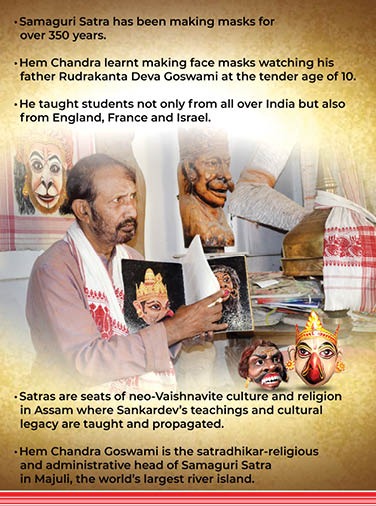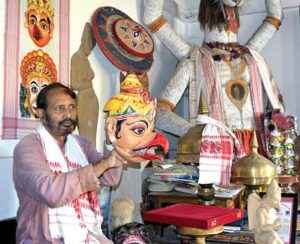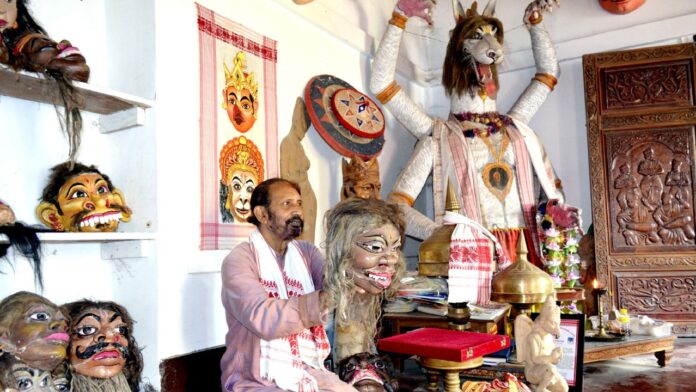Hem Chandra Goswami’s efforts to revive face masks have won him India’s fourth-highest civilian award Padma Shri this year. T P Venu catches up with the master mask maker at Majuli Island
Sitting among bamboo splints, face masks, natural colours and clay, this year’s Padma Shri awardee Hem Chandra Goswami explains about the mask making process with the help of five models neatly placed on the floor at the Satras (monastery) in Majuli Island.
He is the face of Assam in mask making and instrumental in the revival as well as showcasing the ‘Mukha’ meaning traditional masks that depict humans, animals, birds, Gods and demons. The masks form an integral part of traditional theatrical presentations of Bhaonas (plays) started and popularized by 15th century social and religious reformer Srimanta Sankardev.
Is there a demand for face masks? “It is tough but we need to keep it alive,” says Hem Chandra who has been teaching the art to students not just from Assam but across the world since 1984. The little demand for face masks is during the winter months and at the Raas Leela, an annual festival depicting the life of Lord Krishna presented in the performing art form. The lack of interest among youth and fast declining number of plays are reasons for the dip in demand for face masks but Hem Chandra wages a lone battle to keep the tradition alive.
In the past, masks would be made by wood which were heavy and uncomfortable. Two innovations by Hem Chandra i.e., making masks with bamboo, paper and clay and cow dung have made them lighter and eco-friendly. This has helped a great deal in the revival of face masks.
 Mask making in his blood
Mask making in his blood
Life in Majuli Island is steeped in tradition. Growing up in Sri Sri Samaguru Satra, one of the monasteries of the sect created by Srimanta Shankardev, Hem Chandra learnt making face masks watching his father Rudrakanta Deva Goswami at the tender age of 10.
In spite of the demand for face masks waning, intermittent floods damaging homes resulting in destruction of masks and material coupled with the problem of other Satras unable to carry forward the art of making masks, Hem Chandra continued with the tradition. He says, “We wanted the audience to stay glued and by simple ideas such as making masks with moveable jaws and eyes helped a great deal.
In 2016, London’s British Museum displayed five of Goswami’s masks from January to August during an exhibition called “Krishna in the Garden of Assam.”
Srimanta Sankardeva, a social and cultural reformer, who propounded the neo-Vaishnavite movement in 15th Century, composed ‘Ankiya Nat’ which is called Bhaona in Assamese. Hem Chandra Goswami narrates incidents from Ramayana and Bhagavad Gita and explains to the students who had come to purchase masks. He says, “The stories were written in Assamese and Maithili which included ‘Rama Vijaya’, ‘Parijata Haran’, ‘KaliyaDamana’, ‘Rukmini Haran’, ‘Keli Gopala’ and ‘PatniPrasada’.
 Some characters could not be portrayed with a human face and thus came masks for dramatic effect. Hem Chandra Goswami’s efforts were recognised and he has been bestowed with several awards including the Sangeet Natak Akademi Award.
Some characters could not be portrayed with a human face and thus came masks for dramatic effect. Hem Chandra Goswami’s efforts were recognised and he has been bestowed with several awards including the Sangeet Natak Akademi Award.
How long will mask making continue given the fast changing social customs even in Majuli island as youngsters look for better income and move to Guwahati and other states for jobs, we ask. Hem Chandra says, “In every advertisement of the Government that showcases the culture of Assam, masks are a must and Majuli Island figures prominently. So much so, in 2018, at the Republic Day tableau we performed a drama.” He further adds, “There are close to 600 people across the state who make masks. They do not get employment throughout the year but when youngsters evince interest, I am overjoyed and feel there is hope after all.”

 The turnaround can be attributed to investor friendly policy, akin to the one that the Government of India took in 1991 with the New Economic Policy. The several steps that Telangana took includes: speedy clearance aided by a single window, 100 per cent refund on VAT and GST, refund on stamp duty, exemption from Land Ceiling Act, exemption from electricity wheeling charges and not running around to get approval from the State Pollution Control Board.
The turnaround can be attributed to investor friendly policy, akin to the one that the Government of India took in 1991 with the New Economic Policy. The several steps that Telangana took includes: speedy clearance aided by a single window, 100 per cent refund on VAT and GST, refund on stamp duty, exemption from Land Ceiling Act, exemption from electricity wheeling charges and not running around to get approval from the State Pollution Control Board. The most visible area of the state’s renewable energy push has been in public transport system. The Telangana State Road Transport Corporation (TSRTC) for instance teamed up with TSREDCO to install solar rooftop systems on the bus stations, bus depots and workshops. In all, 97 bus depots and 364 bus stations have been covered and the savings are over Rs 2 crore per annum. What is more! It resulted in reduction in carbon emissions by 7,300 tonnes a year.
The most visible area of the state’s renewable energy push has been in public transport system. The Telangana State Road Transport Corporation (TSRTC) for instance teamed up with TSREDCO to install solar rooftop systems on the bus stations, bus depots and workshops. In all, 97 bus depots and 364 bus stations have been covered and the savings are over Rs 2 crore per annum. What is more! It resulted in reduction in carbon emissions by 7,300 tonnes a year.